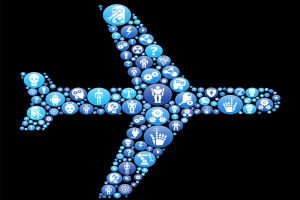A technology-powered smarter era of flight is bringing changes to airlines and their customers
The commercial aviation industry has faced numerous changes, including technological disruption. Even so, many major airlines are embracing AI, machine learning (ML) and the Internet of Things (IoT) as ways to enhance customer experience, trim the budget, and – critically – remain competitive.
With the number of air travelers expected to double by 2037, it’s incumbent on airlines to shift to a data-powered outlook as soon as possible. How are leading airlines using technology to meet passengers’ needs? And what impact can AI and ML, as well as other data-based applications, have on airlines’ internal operations?
AI Onboard: Refining Customers’ Airline Experience
AI and its associated technologies offer a nearly endless list of ways to improve airlines’ customer experience. These range from the mundane (self-service check-ins, user-friendly apps) to the exotic (in-flight virtual reality headsets providing 360-degree immersive entertainment). Below are a few of the tech-powered improvements passengers can enjoy:
- In December 2018, Delta launched its first biometric terminal. This takes the familiar self-check-in kiosk to the next level, using facial recognition and the passenger’s passport photo to speed people through the check-in process and reduce aircraft boarding times.
- Airlines are also using AI and IoT sensors to optimize baggage handling. This includes creating faster routes for baggage trolleys and sending automatic updates to passengers and gate agents should luggage go missing.
- The same beacon-based data can also be utilized to keep passengers informed about delays, wait times, and gate changes via mobile apps. United is adding another layer to the app experience by partnering with Amazon Alexa to deliver voice-based interactions to their customers, allowing travelers to stay in the know without lifting a finger (literally).
- IoT data can also be combined with weather, airport, and navigation data to predict and minimize potential schedule problems. This reduces flight delays and helps control the stress and chaos associated with weather or maintenance events.
- Travelers often struggle with navigating unfamiliar airports, finding transportation, and the rest of the after-flight experience. By collecting and analyzing various kinds of transportation and customer experience data, AI-enhanced apps can guide passengers to the baggage carousel, help them book a ride, and even suggest nearby points of interest to help brighten their post-disembarkation time.
- Airlines can also use AI to personalize and smooth each individual’s airport experience in other ways. For example, they can analyze customer data to provide booking assistance and appealing loyalty rewards. By interacting with customers at various points in their journey – preflight, in-flight, and post-flight – they can deliver actionable offers at exactly the right time. For customers, this can lessen some of the pain points of air travel. Customer data can also be analyzed in the aggregate, allowing airlines and airports to make informed decisions about how to keep their customers happy.
- Some airlines have equipped the cabin crew with a data analytics app that provides detailed information on the passengers sitting in each seat. In flight and during the boarding process, this info can be used to make seating changes and tailor offers to each person’s tastes.
As technology continues to explode, we can expect to see new ways that airlines can use AI, ML, and IoT to continually improve their customers’ journey. But what about the industry’s “inside” – operations, maintenance, fuel savings, etc.?
Reshaping Aviation from the Inside
Airlines are also using cutting-edge technology to improve the safety, reliability, and economy of their internal operations:
- Although it’s not something most passengers think about, employee scheduling is vital to flight safety. Crew members’ qualifications and previous travel (e.g. between multiple time zones), work regulations, flight type, fuel usage, and even flight route all have to mesh; pilots and flight attendants have to meet specific regulatory requirements for time off and maximum working hours; all of this and more has to go into the schedule. Using AI to process information and uncover hidden insights is a tremendous boon to those responsible for safe scheduling.
- On the ground and in the air, machine sensors transmit a wealth of data that can be used to plan predictive maintenance, analyze aircraft performance, and fine-tune fuel management. This not only makes flights safer, it also makes them more economical. Even the in-flight food supply can be optimized for each journey so that planes aren’t carrying too many comestibles (or the wrong kind, which passengers won’t buy).
- Predictive maintenance can also be used to reduce flight cancellations by assessing when various airplane parts are likely to need replacement. By proactively monitoring their fleets, airlines can anticipate needed maintenance, schedule it, and reduce time-consuming, scheduling-disrupting repairs.
- Machine learning techniques like time series analysis and pattern recognition can be used to help find potential flight glitches that could result in a delay or a safety incident. Avoiding these is, of course, paramount.
AI and Airlines’ (Data-Driven) Future
No matter where you are in your AI journey, the following guidelines can help make the transition easier:
As exciting as these applications are, they’re just the beginning of what’s coming to the aviation industry. Airlines have proven themselves very quick to recognize the benefits of AI, ML, and other data-driven technologies; even more importantly, they’ve promptly integrated these new processes into their daily operations.
With the commercial aviation industry poised for more growth and change, we can expect to see AI continue to play an integral part in its function. We’ll see applications that go beyond marketing, beyond customer experience, and beyond profitability. We’ll see a shift towards more and greater AI applications in every aspect of the industry.
Related Absolutdata products and services: AI & Data Sciences, NAVIK AI Platform, NAVIK MarketingAI, Customer Analytics, Marketing Analytics































